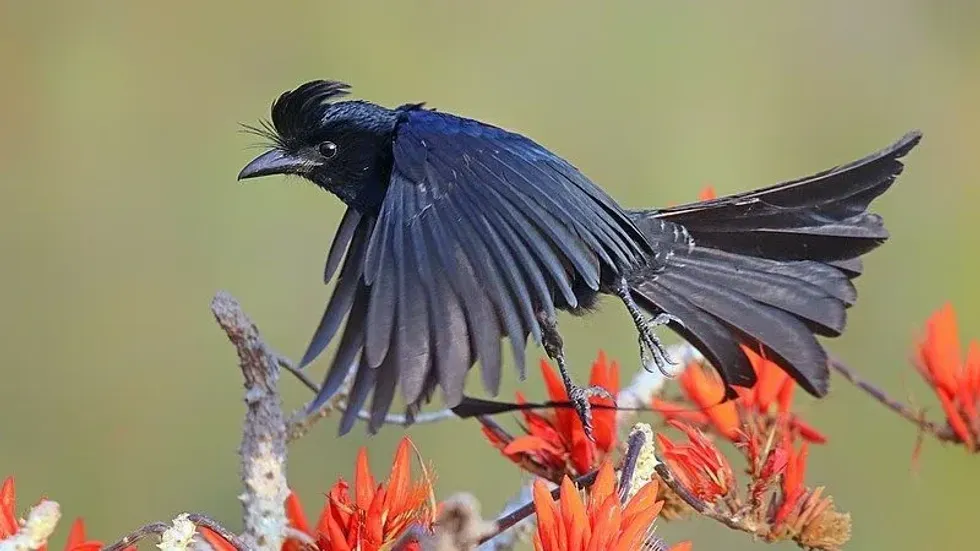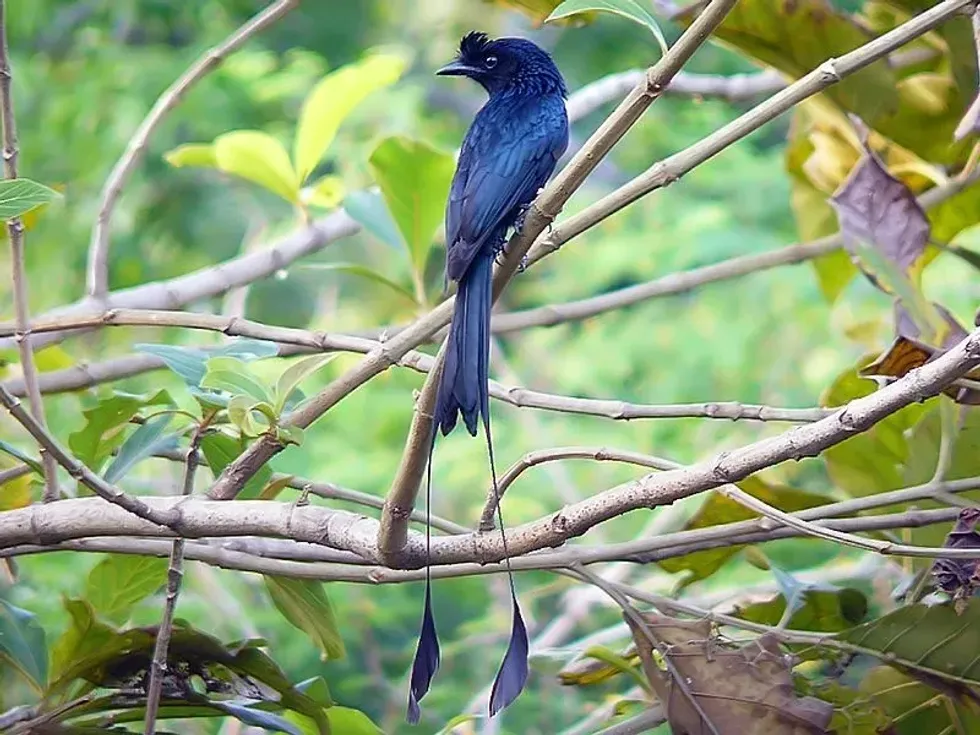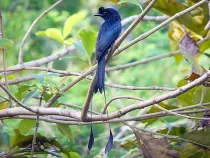Fun Greater Racket-tailed Drongo Facts For Kids
The greater racket-tailed drongo (Dicrurus paradiseus) is a bird that is native to the East Asian regions. These birds are divided into 13 subspecies that have been a part of the fauna of their habitat regions.
Greater racket-tailed drongos are well known for their ability to mimic other birds and can often be found producing various sounds which they use to thwart predators, or just to entertain themselves.
Greater racket-tailed drongos forage in mixed groups and are tolerant for the most part of this foraging process. However, these birds are known to be fearless and will unhesitatingly attack birds that are double or even triple their size in an effort to protect themselves or their nest.
These birds are currently listed as a species of Least Concern due to their large-scale population in their native habitat regions, and will hopefully continue to thrive as long as there is no sudden decline in population as an aftereffect of human interference.
Read on to know more interesting facts about the bird! For more relatable content, check out these fork-tailed drongo facts and drongo facts for kids.
Greater Racket-Tailed Drongo Interesting Facts
What type of animal is a greater racket-tailed drongo?
The greater racket-tailed drongo (Dicrurus paradiseus) is a species of bird that is well-known for its distinct long outer tail feathers which have a web-like formation marked off at the end of the tail.
The greater racket-tailed drongo is from a large drongo family which is further divided into 13 subspecies that can be found all across East Asian regions.
What class of animal does a greater racket-tailed drongo belong to?
Greater racket-tailed drongos are part of the Aves class and come under the Dicruridae family of drongos. These birds have gone through several evolutionary processes as they are one of the best examples of biological evolution through generation drift and isolation.
How many greater racket-tailed drongos are there in the world?
The global population of the greater racket-tailed drongo (Dicrurus paradiseus) is currently unknown as these birds have a vast habitat range that is different for each of the 13 different subspecies. Due to this vast range of habitats, the exact population count is tough to state since they are widespread all through their territory and range.
The Indonesia islands of Bali and Java have seen large-scale clearance of lowlands which has led to the greater racket-tailed drongos becoming rare on the islands.
Where does a greater racket-tailed drongo live?
The greater racket-tailed drongo (Dicrurus paradiseus) can be found in the subtropical regions of East Asia and have a widespread population distribution throughout the region as different subspecies can be found in different locations of the region. These non-migratory birds inhabit India, Bangladesh, Indonesia, Malaysia, Thailand, China, and Sri Lanka, to name a few.
What is a greater racket-tailed drongo's habitat?
Greater racket-tailed drongos prefer to live in humid conditions and are usually found in broadleaf deciduous or evergreen forest regions.
They occur in different elevation ranges throughout their habitat and are found at an elevation of 2,624.7 ft (800 m) in the Malay Peninsula, 3,280.8 ft (1,000 m) in Thailand and Myanmar, 4,593.2 ft (1,400 m) in China, and 4,921.3 ft (1,500 m) on the Indian subcontinent.
The greater racket-tailed drongo inhabits mangroves, teak stands, bamboo jungles, rubber plantations, orchards, gardens, villages, suburban surroundings. These birds can also be found in cultivated areas with tall trees and open country.
The Dicrurus paradiseus ceylonicus subspecies residing in Sri Lanka occur in dry zones. If two subspecies are residing in the same habitat, they will usually avoid each other. However, in Indian regions, subspecies can co-exist in a mixed flock.
Who does greater racket-tailed drongo live with?
The greater racket-tailed drongo (Dicrurus paradiseus) is a territorial bird and can either be solitary or social depending on the subspecies it belongs to. Usually, these birds are found foraging in large groups which may or may not include birds from other species like the babblers.
During the breeding season, the greater racket-tailed drongo becomes more social as both the males and the females search for potential mates.
In case there is a trespasser, greater racket-tailed drongos will not hesitate to fight as they are extremely territorial birds.
In India, the greater racket-tailed drongo is also known for its habit of following the langur monkey in attempts to feed on insects that have been disturbed by the langur's movements.
How long does a greater racket-tailed drongo live?
The lifespan of the greater racket-tailed drongo (Dicrurus paradiseus) is currently unknown due to a lack of data. Based on the studies of this species by the IUCN Red List, it can be stated that they have a generation gap of around three years which means they have a minimum lifespan of approximately three years.
How do they reproduce?
Greater racket-tailed drongos (Dicrurus paradiseus) breed once every year and the breeding season differs on the regions they occur in. The usual breeding season is between early February to late July with variations in localities.
In the northern range of their habitat, greater racket-tailed drongos mate between June and July, and in the southern regions, they tend to breed in February.
Both the male and the female take part in creating nests which are created using intertwined leaves and roots which are lined with materials from the inside. Spider cobwebs are used to hold the nest together and it is topped off with lichens that help in camouflaging the nest to protect the nests from predators like the rat snake.
During the breeding season, the birds form a small flock and choose their mates, and after the mating ritual is done, the male will inseminate the female. Following the insemination, the female greater racket-tailed drongo will lay an average of one to four eggs. The incubation period of the eggs is unknown as of now.
What is their conservation status?
The greater racket-tailed drongo (Dicrurus paradiseus) is not globally threatened and is assumed to have a thriving population due to the vast habitat range these birds inhabit. These birds have been listed as a species of Least Concern on the IUCN Red List.
They are found in protected regions as they occur in wildlife sanctuaries and national parks in their native habitat range. In the Andaman and Nicobar Island regions, these birds are threatened due to rapid logging and mining practices which have led to a loss of habitat.
Greater Racket-Tailed Drongo Fun Facts
What do greater racket-tailed drongos look like?

Both the male and the female greater racket-tailed drongo (Dicrurus paradiseus) are similar in appearance and have distinctive two wire-twisted spatula-tipped streamers at the end of their tails. These birds have a backward-curving crest or tuft on their forehead which is more or less developed in most cases.
The adult greater racket-tailed drongo (Dicrurus paradiseus) usually has black plumage which is a mixture of a strong metallic blue gloss or a greenish-blue gloss that is not present on the flanks, lower abdomen, or quills.
The breast area is small and has traces of glossy feathers with the primary and secondary flight feathers coming together to form a web-like pattern. The neck is heavily covered with feathers and in its fully developed form, creates a glossy cape that covers the entire shoulder.
The feathers at the front create a crest that is backward-curling in nature.
How cute are they?
It can be tough to call the greater racket-tailed drongo (Dicrurus paradiseus) cute due to its crow-like appearance based on its dark black plumage. The crest on their heads gives these birds a unique look that might help them in looking different from crows and add a bit of cuteness factor to their usually dull plumage.
How do they communicate?
The greater racket-tailed drongo (Dicrurus paradiseus) is a bird that is well-known for its mimicking abilities as it can mimic songbirds, raptors, and other groups of birds. In situations where they have to thwart off predators, they can mimic the osprey, a bird of prey. They can also mimic small birds like the wood thrush for entertainment.
Greater racket-tailed drongos communicate with each other using whistles, and metallic calls that are common among all species of drongos.
How big is a greater racket-tailed drongo?
The greater racket-tailed drongo (Dicrurus paradiseus) is a medium-sized bird that grows between 11.8-25.6 in (30-65 cm) including their long flowing tail. This bird is larger than the common square-tailed drongo which grows up to 7.5 in (19 cm) in body length.
How fast can a greater racket-tailed drongo fly?
The flight speed of the greater racket-tailed drongo (Dicrurus paradiseus) is currently unknown.
How much does a greater racket-tailed drongo weigh?
A greater racket-tailed drongo (Dicrurus paradiseus) weighs between 2.5-4.4 oz (70-125 g) as full-grown adults.
What are the male and female names of the species?
Neither the male nor the female greater racket-tailed drongo (Dicrurus paradiseus) has a sex-specific name assigned to it.
What would you call a baby greater racket-tailed drongo?
A baby racket-tailed drongo (Dicrurus paradiseus) is called a chick.
The juvenile drongo has a browner plumage compared to the adults and has white fringes on the abdomen feathers. Their tail is shorter with a poorly developed tail-racquet. Subadults have a less glossy plumage with an underdeveloped crest that is not as curly as those of the adults.
What do they eat?
The greater racket-tailed drongo (Dicrurus paradiseus) is an omnivorous bird and has a plant and insect-based diet that is comprised mostly of small insects and bugs like ants, locusts, moths, dragonflies, and termites which they catch in mid-air. Flower nectar is also an important component of this bird's diet.
Are they dangerous?
The greater racket-tailed drongo (Dicrurus paradiseus) is not a dangerous bird, at least towards humans as they seem to shy away from human interactions. These birds will not hesitate to attack larger birds species like the hawk or eagle if they come close to their nests, especially during the breeding season.
Would they make a good pet?
No, since this bird is wild in nature it will not make a good pet.
Did you know...
In certain parts of India, this bird was kept in captivity prior to the 1950s.
The courtship behavior of this bird includes dropping an object and catching it mid-air to impress potential mates.
The Indian cuckoo is among the few bird species that lay its eggs in the nest of drongos which is a sign of brood parasitism.
The long tail of this bird creates a humming sound when it is in flight.
The greater racket-tailed drongo falls under the category of birds that have no negative impact on humans.
What do the drongos do during the day?
The greater racket-tailed drongo (Dicrurus paradiseus) is a diurnal bird and spends most of its daytime foraging for food. They can also be active during late dusk.
Where does the word drongo come from?
The word 'drongo' has an Australian origin as it is used as a mild insult that refers to someone who is not intelligent.
The use of this word has been derived from an Australian racehorse of the same name as the spangled drongo who never won a race despite always being in the top three.
Here at Kidadl, we have carefully created lots of interesting family-friendly animal facts for everyone to discover! Learn more about some other birds from our pine marten fun facts and shoebill surprising facts pages.
You can even occupy yourself at home by coloring in one of our free printable four calling birds coloring pages.
Main image by Sandeep Gangadharan.
Second image by Md Shahanshah.
We Want Your Photos!
More for You
See All
Bachelor of Arts specializing in Journalism and Mass Communication, Postgraduate Diploma in Sports Management

Moumita DuttaBachelor of Arts specializing in Journalism and Mass Communication, Postgraduate Diploma in Sports Management
A content writer and editor with a passion for sports, Moumita has honed her skills in producing compelling match reports and stories about sporting heroes. She holds a degree in Journalism and Mass Communication from the Indian Institute of Social Welfare and Business Management, Calcutta University, alongside a postgraduate diploma in Sports Management.
Disclaimer
1) Kidadl is independent and to make our service free to you the reader we are supported by advertising. We hope you love our recommendations for products and services! What we suggest is selected independently by the Kidadl team. If you purchase using the Buy Now button we may earn a small commission. This does not influence our choices. Prices are correct and items are available at the time the article was published but we cannot guarantee that on the time of reading. Please note that Kidadl is a participant in the Amazon Services LLC Associates Program, an affiliate advertising program designed to provide a means for sites to earn advertising fees by advertising and linking to Amazon. We also link to other websites, but are not responsible for their content.
2) At Kidadl, we strive to recommend the very best activities and events. We will always aim to give you accurate information at the date of publication - however, information does change, so it’s important you do your own research, double-check and make the decision that is right for your family. We recognise that not all activities and ideas are appropriate for all children and families or in all circumstances. Our recommended activities are based on age but these are a guide. We recommend that these ideas are used as inspiration, that ideas are undertaken with appropriate adult supervision, and that each adult uses their own discretion and knowledge of their children to consider the safety and suitability. Kidadl cannot accept liability for the execution of these ideas, and parental supervision is advised at all times, as safety is paramount. Anyone using the information provided by Kidadl does so at their own risk and we can not accept liability if things go wrong.
3) Because we are an educational resource, we have quotes and facts about a range of historical and modern figures. We do not endorse the actions of or rhetoric of all the people included in these collections, but we think they are important for growing minds to learn about under the guidance of parents or guardians.







